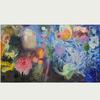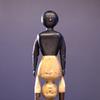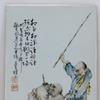The Impressionist art of Clark Greenwood Voorhees comes to light
- December 02, 2009 11:40
Tucked away for decades in the private collections of the artist's descendants, many of the best large-scale oil paintings by Clark Voorhees (1871-1933) are now re-emerging in an exhibition at New York City's Hawthorne Fine Art. The Light Lies Softly: the Impressionist Art of Clark Greenwood Voorhees, on view from December 15, 2009 through February 27, 2010, will showcase about thirty-two of the artist's finest landscapes depicting New England, Bermuda, and Newport, Rhode Island. There are 23 works for sale, with prices ranging from $6,500 up to $110,000.
Jennifer C. Krieger, managing partner of Hawthorne Fine Art, writes of her attraction to the artist's lyrical landscapes in the exhibition catalog foreword:
"It is with a true love of Voorhees' unique style that this exhibition was born, a love for the flickering of light, the rich softness of color, and the rippling of texture, all inherent in his touch. While Impressionist pictures often seem most effective when viewed from afar, I urge the viewer of Voorhees' works to inspect them closely and appreciate their tactile delicacy, the warp and woof of the artist's imagination."
Voorhees, born in 1871 in New York City, was first drawn to a career in science, earning a B.A. in Chemistry from Yale and an M.A. in the same subject from Columbia. When laboratory work became increasingly unfulfilling, Voorhees turned his attention to observing nature and sketching out-of-doors. A stint at the Art Students League led him to study art further in Paris at the famed Académie Julian.
The budding artist was also an avid cyclist. A momentous bicycle trip to Old Lyme, Connecticut, in 1893, turned into a long love affair with the picturesque region. Voorhees became the first artist to board with the gregarious hostess, Miss Florence Griswold. Her boarding house came to attract many more American Impressionists, ultimately creating the influential turn-of-century Old Lyme Art Colony. Barbizon School proponent Henry Ward Ranger arrived in 1899 and, in 1903, came Childe Hassam, whose explosive color and striated brushtrokes influenced Voorhees' subdued tonalist style.
Voorhees exhibited widely with members of the Old Lyme Art Colony. His work was well-received at exhibitions held by the National Academy of Design, the Society of American Artists, the American Watercolor Society, the Carnegie Institute, and the Art Institute of Chicago. He was also the recipient of several honors, including a bronze medal at the 1904 St. Louis Exposition.
Yet, Voorhees was not a self-promoter, and he gave many of his best paintings to his own family, who have long-cherished his work in private collections; therefore, Voorhees has perhaps not been fully appreciated. Krieger writes, "The Light Lies Softly aims to remedy this situation by revealing the beauty of Voorhees’s distinctive brand of Impressionism, one that was tempered by a lasting allegiance to the tenets of Tonalism."
Among the prime examples of Voorhees' oevure in the exhibition is "Cliff Walk, Newport, Rhode Island" (1916), an impressionistic oil most likely painted en plein air. The scene depicts the artist's wife and three children on a sunlit picnic, situated in golden grass on a cliff overlooking the azure Atlantic. The painting bears a resemblance to William Merritt Chase's "Idle Hours" (1894; Amon Carter Museum), a composition Voorhees may have seen on an 1895 visit to Chase's studio. The subject matter also brings to mind Claude Monet's "Wild Poppies near Argenteuil" (1873; Musée d'Orsay), a bright scene where the French Impressionist's wife and son meander through a field of red poppies.
A host of works in this exhibition, from pastel-hued Bermuda scenes created during his winter stays after 1919, to ethereal nocturnes and quintessential Old Lyme landscapes, filled with pink apple blossoms or muted green hillsides, provide an appealing overview of Voorhees' signature style. With certain adeptness, Voorhees wove together the vibrant palette and painterly brushwork of the Impressionists with the softness of Tonalism, sensitively fusing and transforming styles to create a singular body of work.
A 40-page exhibition catalog, with an essay by Marshall N. Price and foreword by Jennifer C. Krieger, is available from Hawthorne Fine Art. E-mail: info@hawthornefineart.com; tel. 212.731.0550.






100x100_n.jpg)

100x100_c.jpg)












